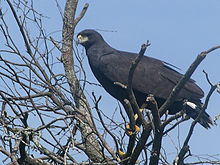Buteogallus is a
genus of
bird of prey in the
family Accipitridae. All members of this genus are essentially
Neotropical, but the distribution of a single species extends slightly into extreme southern
USA. Most are known as
black-hawks (though not all
species are dark) or
mangrove-hawks (though can also be found far inland). For the entire group the name
crab-hawks seems most apt, in reference to the fact that all species are quite fond of large
crustaceans and will even patrol long stretches of shore or riverbank on foot where such prey abounds, but there are a number of birds with somewhat different lifestyle which appear so closely related that they ought to be included here.
Almost all species have a very characteristic tail pattern. This consists of a black base, a wide white middle band, a roughly equally wide black band, and a quite narrow white band on the feathertips that is often hard to discern or may be lost when the feathers are very worn. In the
Great Black-hawk, the basal black is either missing or wider depending on
subspecies, but in the former case the body near the tail base is black, resulting in an almost identical appearance. Only the
Rufous Crab-hawk has a very different tail pattern (see also below).
Systematics and taxonomy
This genus contains the following
species, sorted according to putative relatedness:
- Rufous Crab Hawk, Buteogallus aequinoctialis
- Common Black Hawk, Buteogallus anthracinus
- Mangrove Black Hawk, Buteogallus (anthracinus) subtilis – formerly considered a distinct species, but now considered a subspecies.
- Cuban Black Hawk, Buteogallus gundlachii – formerly included in B. anthracinus
- Great Black Hawk, Buteogallus urubitinga
- Savanna Hawk, Buteogallus meridionalis
However, delimited so strictly the genus is probably
paraphyletic. The solitary eagles (
Harpyhaliaetus) are a more continental relative of the "black" group of
Buteogallus – in
phenotype they are essentially hefty
Common Black-hawks with lighter body plumage and in one species a small tuft. Insofar as there are differences in
anatomy, these seem to be related to the different prey they hunt (namely
reptiles). Together with the
Savanna Hawk, they seem to be close to some species uncomfortably placed in
Leucopternis. As that genus is apparently
polyphyletic, it seems as if the best course of action would be to unite the crowned eagles with
Buteogallus, as well as some "
Leucopternis", to agree with the
morphological and
mtDNAsequence data.
These would include the
Plumbeous Hawk (
L. plumbeus) and the
Slate-coloured Hawk (
L. schistaceus), which since long were proposed time and again to be placed in
Buteogallus. Together with the crab-hawks and solitary eagles form a sequence of plumage patterns that nicely agrees with the DNA-based phylogeny:
L. schistaceus looks very much like a smaller, shorter-legged and lighter Common Black Hawk, while the
basal L. plumbeus lacks the tail pattern. The case of the
White-necked Hawk (
L. lacernulatus) is more puzzling. It is visually and
ecologically almost identical to the
sympatric Mantled Hawk (
L. polionotus) and some
allopatric White Hawks (
L. albicollis) but differs in tail color. According to the mtDNA data, it is very closely related to the Savanna Hawk, which is visually completely unlike, appearing like a very light
Buteogallus which has an ochre-grey coloration due to abundant
pheomelanins. Either there has been strong
convergent evolution in plumage and ecology - perhaps a case of
mimicry - between the White-necked and the Mantled Hawks, or the mtDNA data is misleading due to ancient
hybrid introgression. In the respect, it is interesting to note that the White-necked Hawk specimen sampled showed indications of
heteroplasmy.
The placement of the peculiarly
apomorphic Rufous Crab-hawk in regard to all these birds must be considered unresolved for the time being.
Fossil record

Buteogallus fragilis fossil
The
fossil record of
Buteogallus has meanwhile turned out to be quite rich indeed, with many species being erroneously assigned to other genera at first. The genus – like many
buteonines of today – probably succeeded earlier birds of prey during the
Miocene and never seems to have occurred outside the
Americas. From the time of the
last ice age, an array of prehistoric species is known, some of them very large. On
Cuba, a particularly gigantic species survived deep into the last ice age, but probably not until human settlement.
In addition, if the solitary eagles merged into
Buteogallus, the prehistoric
Amplibuteo would almost certainly have to be merged herein too, as it is hardly distinct from
Harpyhaliaetus.









